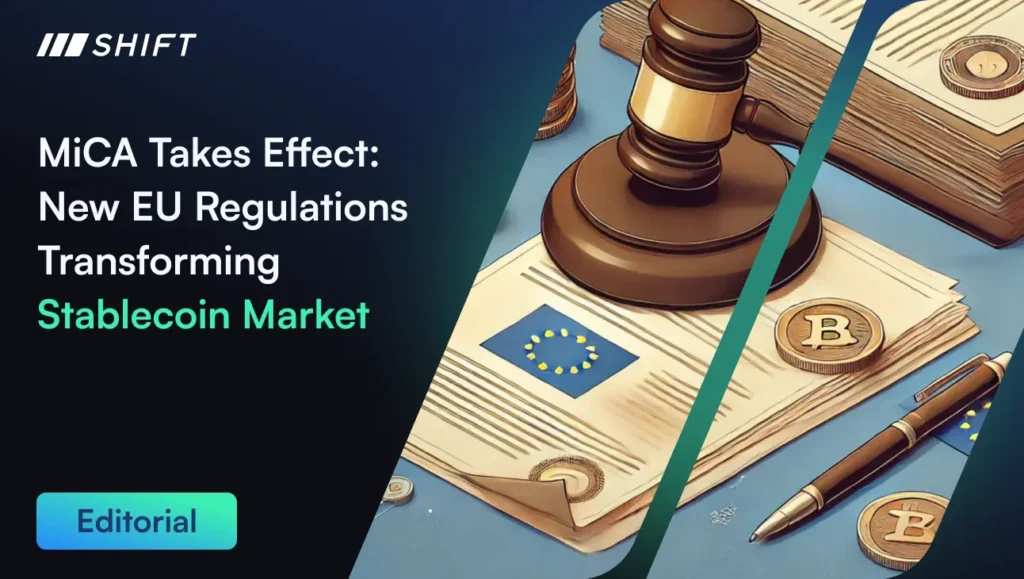Summarize with AI:
The EU’s Markets in Crypto-Assets Regulation (MiCA) has officially taken effect, imposing strict licensing requirements and transaction caps on stablecoin issuers. This landmark legislation aims to enhance consumer protection and market integrity while supporting innovation, fundamentally altering the operational landscape for major players like Tether and Circle in the European crypto market.
MiCA Takes Effect: New EU Regulations Transforming Stablecoin Market
There’s been a massive regulatory shift in the European crypto market as the EU’s Markets in Crypto-Assets Regulation (MiCA) has officially taken effect. As of June 30, 2024, the new rules impose strict licensing requirements and transaction caps on stablecoin issuers, fundamentally altering the operational landscape for major players like Tether and Circle.
This landmark legislation aims to enhance consumer protection and market integrity while supporting innovation within the EU’s financial system. The immediate impact is significant, with platforms and issuers scrambling to comply with the stringent new standards to continue their operations in Europe.
A Quick Recap – How We Got Here
The journey to MiCA’s implementation began with the European Union’s recognition of the need for a unified regulatory framework for crypto assets. Over the past few years, the rise of stablecoins and their increasing use in financial transactions highlighted gaps in the existing regulations, which primarily focused on anti-money laundering and counter-terrorist financing.
The collapse of projects like Terra Luna’s UST and the broader volatility in the crypto market underscored the risks associated with unregulated stablecoin activities. In response, the EU drafted MiCA to establish comprehensive rules governing crypto asset issuers and service providers, ensuring transparency, consumer protection, and financial stability. Following extensive consultations and legislative processes, MiCA was voted into law last year, setting the stage for the current regulatory overhaul.
We did a full breakdown of MiCA’s impact on the crypto industry, detailing the new regulations and their implications for stablecoins. Read the complete article here.
What This Means for Stablecoins
The implementation of MiCA introduces a new era of regulation for stablecoins within the European Union. Issuers of asset-referenced tokens (ARTs) and e-money tokens (EMTs) must now obtain a MiCA license to continue their operations legally in the EU. This includes adhering to strict transaction caps, with stablecoins limited to a maximum of 1 million transactions or 200 million euros in daily value.
Major issuers like Tether and Circle face significant compliance challenges, including the costly and time-consuming process of securing the necessary licenses. The regulation aims to prevent stablecoins from undermining the euro, enhance consumer protection, and ensure market integrity, marking a significant shift in the crypto landscape. This new framework could also lead to operational adjustments or the suspension of certain stablecoin activities within the region.
Immediate Industry Reactions
The crypto industry has reacted swiftly to the new MiCA regulations, with major platforms and issuers already taking steps to comply. Circle has announced its commitment to securing an e-money license and has plans to issue its euro-backed stablecoin, EURC, from Circle France in accordance with MiCA. Tether, on the other hand, is engaging with its European exchange partners to navigate the new requirements, although it faces significant hurdles due to the extensive daily transaction volumes of its USDT token. Exchanges like Binance and Bitstamp have started to delist certain stablecoins to align with the new regulatory environment.
While some industry leaders have expressed concerns about the potential stifling of innovation, others see this as a necessary step toward greater transparency and stability in the crypto market. The full impact of these regulations will unfold over the coming months as the industry adjusts to this new regulatory landscape.
For those looking to successfully maneuver MiCA regulations and obtain the necessary licenses in the EU, Shift Markets provides expert guidance and support.
Share this article:
Want to learn more?
Let us save you time by walking you through what Shift can do for your business!



